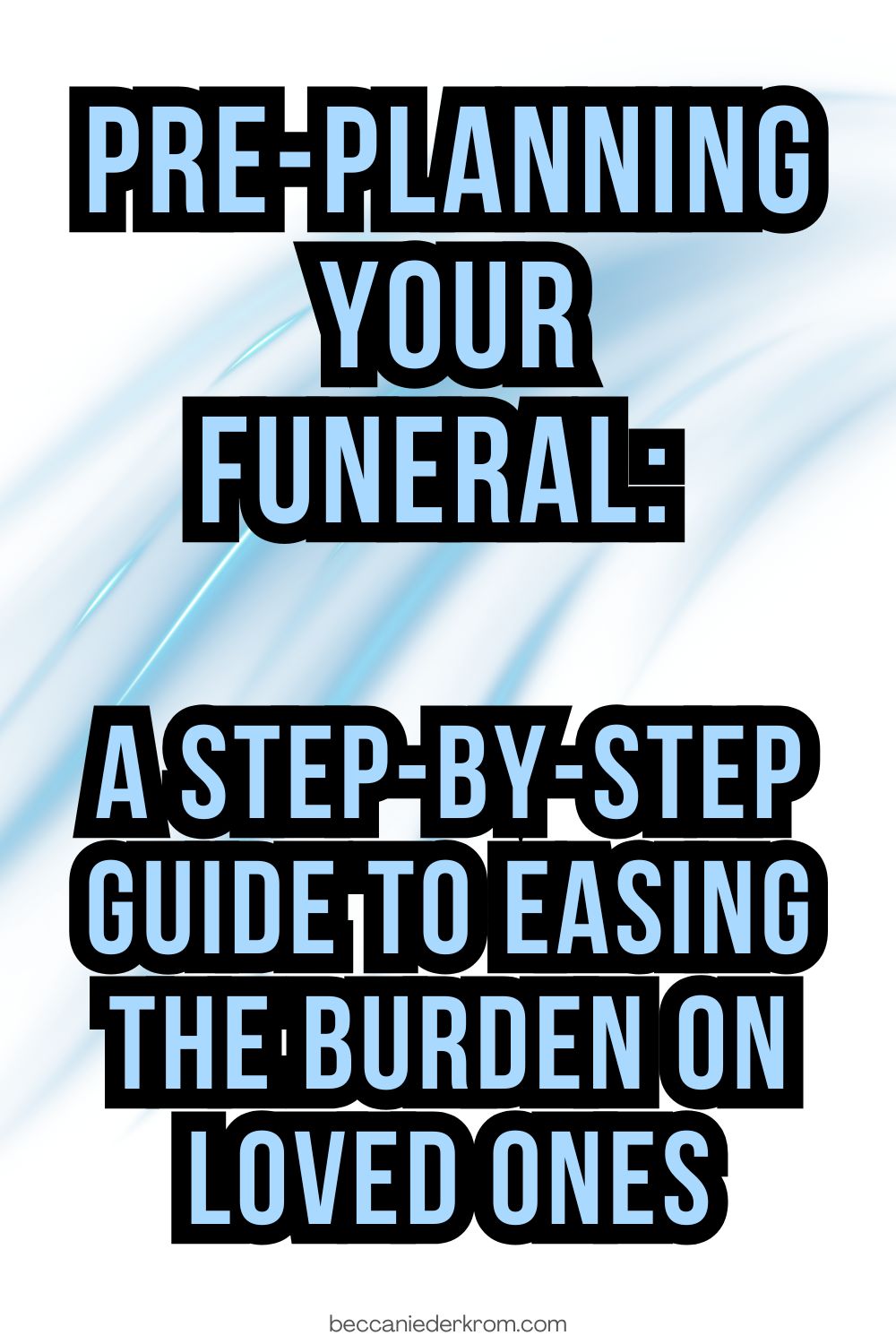We may earn money or products from the companies mentioned in this post. As an Amazon Associate I earn from qualifying purchases. Disclosure of Material Connection: Some of the links in this post may be "affiliate links." This means if you click on the link and purchase an item, I will receive an affiliate commission.
Planning for the end of life is one of the most considerate gifts you can give to your loved ones. While discussing funeral arrangements may feel uncomfortable, pre-planning your funeral alleviates emotional and financial stress for your family during an already difficult time. This comprehensive guide walks you through the process of pre-planning your funeral, providing practical steps and considerations to create a meaningful plan that honors your wishes and supports those you leave behind.
Pre-Planning Your Funeral: A Step-by-Step Guide to Easing the Burden on Loved Ones

Why Pre-Planning Your Funeral Matters
Emotional Benefits for Loved Ones
- Eliminating the guesswork about your wishes, preventing potential disagreements among family members
- Reducing decision fatigue during a time of grief and emotional vulnerability
- Creating space for proper grieving rather than logistical planning
- Providing comfort through the knowledge that they’re honoring your specific wishes
- Offering a structured path forward during a disorienting time
Financial Advantages
- Protection against inflation when pre-funding funeral arrangements
- Opportunity to make thoughtful decisions without emotional overspending
- Ability to research and compare prices without time pressure
- Prevention of financial burden on family members
- Potential to allocate funds appropriately for what matters most to you
Personal Empowerment
- Ensuring your life is celebrated according to your values and preferences
- Creating peace of mind knowing your affairs are in order
- Providing an opportunity for life reflection and legacy consideration
- Allowing you to make clear-headed decisions about important matters
- Giving you control over how you’ll be remembered
Step 1: Start the Conversation
Choosing the Right Time and Setting
- Select a relaxed, private setting without time constraints
- Choose a neutral time, not during holidays or family celebrations
- Consider linking the conversation to related life events, such as updating your will
- Approach the topic during natural discussions about the future
- Plan a dedicated family meeting specifically for this purpose
Framing the Conversation Positively
- Present pre-planning as a gift you’re giving to your loved ones
- Emphasize that you’re not anticipating imminent death but being practical
- Share articles or resources about funeral pre-planning to normalize the discussion
- Begin with your values and how you’d like to be remembered
- Use examples of how pre-planning has helped other families you know
Involving Key Family Members
- Spouse or partner who will likely be most involved in carrying out your wishes
- Adult children who may have responsibilities in executing your plans
- Siblings or close friends who may provide support to your immediate family
- The person you’ve designated as your healthcare proxy or power of attorney
- Any family member who might have strong emotional reactions to these discussions
Step 2: Clarify Your Final Wishes
Disposition Method
- Traditional burial in a cemetery
- Cremation with various options for the cremated remains
- Green or natural burial
- Body donation to medical science
- Alternative methods such as alkaline hydrolysis or human composting (where legal)
Type of Service
- Traditional religious funeral service
- Memorial service without the body present
- Celebration of life focused on positive remembrance
- Direct disposition without a formal service
- Private family gathering versus public service
- Virtual or hybrid service options for distant loved ones
Personal Elements
- Music selections that hold special meaning
- Readings, poems, or religious texts to be included
- Speakers you’d like to deliver eulogies or remembrances
- Photos or videos to be displayed
- Personal items to be incorporated into the service
- Specific attire for yourself or attendees
Location Preferences
- Religious institution such as a church, synagogue, or mosque
- Funeral home chapel
- Cemetery grounds
- Meaningful location such as a park, beach, or family property
- Community center or event venue
- Your home or garden
Final Resting Place
- Cemetery plot location and type
- Mausoleum or columbarium preference
- Scattering location for cremated remains
- Memorial garden or conservation area
- Family property or private land
- Division of cremated remains among multiple locations
Step 3: Research Service Providers
Funeral Homes
- Reputation and reviews from other families
- Range of services offered and alignment with your preferences
- Transparency in pricing and willingness to work within your budget
- Cultural or religious sensitivity relevant to your background
- Personality and communication style of the funeral director
- Location and accessibility for your family members
Cemeteries
- Location and accessibility for future family visits
- Types of plots available (individual, companion, family)
- Perpetual care provisions and maintenance standards
- Monument and marker regulations
- Religious or cultural affiliations if important to you
- Costs for plots, opening/closing fees, and monuments
Cremation Providers
- Direct cremation providers versus full-service funeral homes
- Crematory ownership (on-site or third-party)
- Witnessing options if family presence is important
- Container requirements and options
- Return process for cremated remains
- Certification and adherence to ethical standards
Green Burial or Alternative Providers
- Certified green burial grounds in your region
- Levels of conservation commitment (hybrid, natural, or conservation burial)
- Availability of biodegradable caskets or shrouds
- Providers of alternative disposition methods in your area
- Regulations and requirements for each option
Step 4: Consider Financial Arrangements
Pre-Need Funeral Insurance
- Typically offered through funeral homes
- Often guarantees today’s prices for future services
- Usually involves single premium or installment payments
- May be transferable if you relocate
- Funds go directly to the funeral provider upon death
Funeral Trust Accounts
- Can be established through funeral homes or financial institutions
- Funds are held in trust specifically for funeral expenses
- May offer protection from Medicaid spend-down requirements
- Can be revocable or irrevocable depending on your needs
- Typically grows with interest over time
Traditional Life Insurance
- Provides flexibility in how beneficiaries use the funds
- Not tied to a specific funeral provider
- May serve multiple financial needs beyond funeral costs
- Often requires medical underwriting for new policies
- Beneficiaries receive funds directly and then pay for services
Payable-on-Death Accounts
- Standard bank account with a designated beneficiary
- Avoids probate process for quick access to funds
- Remains under your control during your lifetime
- Earns interest like regular savings accounts
- Not specifically limited to funeral expenses
Setting Aside Savings
- Provides maximum flexibility and control
- No fees or commissions to financial products
- Can be used for other purposes if needed
- May be subject to probate depending on account structure
- Requires discipline to maintain the designated funds
Step 5: Document Your Plan
Funeral Planning Documents
- Contact information for your chosen funeral provider
- Detailed service preferences and instructions
- Disposition method and location specifications
- Personal elements to be included in the service
- Names of individuals you’d like to participate in the service
- Financial arrangements you’ve made for expenses
- Location of any pre-purchased cemetery plots or contracts
Important Supporting Documents
- Birth certificate
- Marriage certificate
- Military discharge papers (DD-214) for veterans
- Social Security information
- Insurance policies
- Pre-need funeral contracts
- Cemetery deed or columbarium contract
- Organ/tissue donation registration
Obituary Preparation
- Biographical information you want included
- Career highlights and accomplishments
- Organizations and affiliations to mention
- Family members to be listed
- Preferred charity for memorial donations
- Special messages or quotes to include
- Photos you’d like to accompany the obituary
Digital Legacy Instructions
- Social media account preferences (memorialization or deletion)
- Email account access information
- Digital photo storage locations and access details
- Website or blog management instructions
- Digital subscription cancellations
- Password manager information for authorized individuals
Step 6: Communicate and Store Your Plan
Sharing Your Plan
- Provide copies of your funeral planning documents to your spouse, adult children, or other close family members
- Discuss your plans with your estate executor or trustee
- Consider sharing with your attorney who handles your estate planning
- Inform your healthcare proxy, especially regarding anatomical gifts
- Let close friends know about your arrangements if they might be involved
Proper Storage
- Keep original documents in a fireproof, waterproof container
- Do not store in a safe deposit box that may be sealed upon death
- Consider a secure digital copy in an online storage service
- Ensure your executor knows where to find physical documents
- Update your “In Case of Emergency” contact information to include document locations
Regular Review and Updates
- Schedule annual reviews of your funeral pre-planning documents
- Update after major life changes (marriage, divorce, relocation)
- Revise if your preferences or values change over time
- Confirm that pre-arrangements with service providers remain valid
- Verify that funding mechanisms remain adequate as costs change
Step 7: Address Additional End-of-Life Considerations
Advance Healthcare Directives
- Living will outlining treatment preferences
- Healthcare power of attorney designation
- Do Not Resuscitate (DNR) orders if desired
- POLST (Physician Orders for Life-Sustaining Treatment) forms
- Organ and tissue donation registration
Estate Planning Documents
- Last will and testament
- Trust documents if applicable
- Financial power of attorney
- Beneficiary designations on financial accounts
- Property deeds and titles
Legacy Planning
- Ethical will or legacy letter sharing values and life lessons
- Charitable bequests or foundation establishment
- Family history documentation or memoir
- Memory items prepared for loved ones
- Annual remembrance suggestions for family
Care Planning
- Long-term care insurance or financial planning
- Preferences for home care versus facility care
- Hospice care preferences
- Caregiver identification and support planning
- Comfort and dignity priorities for end-of-life care
Common Challenges in Funeral Pre-Planning
Family Resistance
- Approach conversations with sensitivity and patience
- Share articles about the benefits of pre-planning
- Start with general topics before specific details
- Respect emotional boundaries while gently encouraging participation
- Consider involving a neutral third party such as a counselor or clergy member
Changing Circumstances
- Relocation to a different region
- Changes in family relationships
- Financial situation fluctuations
- Evolution in personal values or religious beliefs
- New options becoming available in the funeral industry
Decision Overwhelm
- Break the process into smaller steps tackled over time
- Focus on major decisions first, then address details
- Consider working with a funeral planning professional
- Use pre-planning checklists to ensure thoroughness
- Remember that some flexibility can always be left for your family
Emotional Barriers
- Acknowledge that discomfort is normal and temporary
- Focus on the positive impact of your planning
- Take breaks when needed rather than rushing the process
- Consider journaling about your feelings alongside practical planning
- Seek support from friends who have completed their own pre-planning

